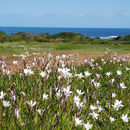Biology
provided by Arkive
The cape buttercup is a perennial plant (4), meaning that it lives for more than two seasons and, after an initial period, produces flowers once a year (7). The large flowers appear between August and September (2), and are pollinated by a range of insects, including bees, scarab beetles, and tabanids (8). A cape buttercup plant may live for approximately ten years (5).
Conservation
provided by Arkive
There are a number of protected areas within the Cape Floristic Region and several conservation projects being undertaken, which the cape buttercup may benefit from (10). The Custodians of Rare and Endangered Flowers (CREW), an initiative which has been involving communities in monitoring and conserving threatened plants in the Cape Floristic Region since 2003, mapped the natural vegetation of Tulbagh as part of the Tulbagh Renosterveld Project (11). The data collected by CREW confirmed the threatened status of S. g. grandiflora and alerted conservationists and local farmers to the importance of preventing further declines in the remaining populations (5). In addition, the cape buttercup, along with many other plants in the Cape Floristic Region, may benefit from a partnership between the wine industry and the conservation sector to conserve the rich biodiversity of this area. The Biodiversity and Wine Initiative (BWI) arose out of concern that some of the region's vulnerable natural habitat might be targeted for vineyard expansion, and aims to prevent further loss of natural habitat in important sites, and promote changes in farming practices to enhance the suitability of vineyards as habitat for biodiversity, and reduce practices that have negative impacts. For example, the wine-producing owner of land at Contreberg set aside an area as a wildflower reserve, where the cape buttercup grows (9).
Description
provided by Arkive
This perennial plant is well suited to its scientific name grandiflora, meaning 'large-flowered', as it bears prominent, cup-shaped flowers, in vivid shades of white, yellow or purple (4). The flowers, each measuring 35 to 45 millimetres across (4), are arranged in a cluster on the unbranched stem (5). The cape buttercup produces a fan of fairly succulent, sword-shaped leaves (4) (6), and an underground storage organ, or corm (2). The fruit of the cape buttercup is a capsule, within which are large, spherical, shiny seeds (5).
Habitat
provided by Arkive
The cape buttercup grows on stony clay flats and slopes in renosterveld vegetation (2).
Range
provided by Arkive
Endemic to the Cape Floristic Region, an area of incredible plant diversity in south-western South Africa. The cape buttercup is distributed within this region from Clanwilliam south to Bredasdorp (2). The subspecies S. g. grandiflora is restricted to a few localities within the Tulbagh Valley (5).
Status
provided by Arkive
Subspecies Sparaxis grandiflora grandiflora is classified as Endangered (EN) on the Interim Red Data List of South African Plant Taxa. Subspecies Sparaxis grandiflora violacea and Sparaxis grandiflora fimbriata are awaiting assessment (3).
Threats
provided by Arkive
The subspecies S. g. grandiflora is classified as Endangered due to its small distribution. Previously more widespread, the expansion of agriculture, particularly vineyards and wheat fields, has taken its toll, and this subspecies can now only be found in small patches of natural renosterveld habitat that remain between agricultural lands. These remaining populations of S. g. grandiflora are threatened by pesticides, affecting the plant and its insect pollinators, and fertilisers, overloading the plant with excessive nutrients, that run-off the adjacent fields (5). With 90 percent of South Africa's wine production occurring within the Cape Floristic Region (9), the further expansion of vineyards poses a constant and significant threat to the survival of this subspecies (5).
Sparaxis grandiflora
provided by wikipedia EN
- license
- cc-by-sa-3.0
- copyright
- Wikipedia authors and editors
Sparaxis grandiflora: Brief Summary
provided by wikipedia EN
Sparaxis grandiflora, the plain harlequin flower, is a species of flowering plant in the genus Sparaxis, family Iridaceae, found in the Western Cape province of South Africa. It has gained the Royal Horticultural Society's Award of Garden Merit.
- license
- cc-by-sa-3.0
- copyright
- Wikipedia authors and editors

